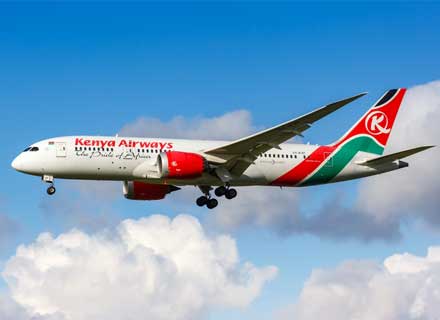The debt load of Kenya Airways, which is reportedly estimated to be around 187.74 billion shillings (USD 1.35 billion), has now emerged as a major concern for potential investors looking to bid on a stake in the African state-owned airline.
The airline’s officials embarked on corporate missions to promote the company’s equity offer in the United States, China and the Middle East but the exercise seems to be a futile one as the venture has failed to receive investment commitments so far, as per a report from the Business Daily newspaper.
“All the potential investors agreed that the fundamentals of the company are very strong,” Kenya Airways CEO Allan Kilavuka said, adding the concern was on the debt level.
He also advised the need to lower the airline’s debt to get extra funding for the business.
In December 2022, Kenya’s President William Ruto led a delegation to Washington with a pitch to sell a controlling stake in the KQ.
The airline, as of May 31, 2023, owes up to USD 1.35 billion to creditors, including the 61.4 billion Shilling (USD 439.8 million) Tsavo facility related to the carrier’s acquisition of six Boeing 787-8 aircraft, one Boeing 777-300 ER aircraft and one Genx engine in 2012.
Kenya’s National Treasury has already indicated about not providing any capital injection for the troubled airline for the 2023/24 financial quarter.
Since 2020, KQ has been relying heavily on Kenyan taxpayers to sustain its operations amid its business downturn. The Kenyan Treasury provided Sh20 billion and Sh30 billion respectively for the 2021/22 and 2022/23 financial years, but it seems now the government is in no mood to keep its national carrier floating with the taxpayers’ money.
In March 2023, Kenya Airways reported a Sh38.3 billion loss for the full year period ending in December 2022. The figure doubled from the 2021 stats and marked the tenth consecutive financial year, where the company’s business health has remained in the red zone.
While Kenya Airways’ performance got reportedly impacted due to the Ukraine war and the resultant escalation of aviation fuel prices, the company recently reduced its losses by 17.6% to Sh5.6 billion, as per the reports.
In 2018, the crisis-ridden airlines even proposed to own aviation assets through a private investment proposal that would have seen the Jomo Kenyatta International Airport being operated and upgraded by a special purpose vehicle for the next 30 years.
However, the airline is now putting its stakes on its ‘Project Kifaru’ plan, which will ensure its fleet and network optimisation, along with collective bargaining, comprehensive capital restructuring, and last but not the least, partnership expansion across the continent of Africa, while terminating aircraft sub-leases.
Kenya Airways has even entered into an interline deal with Emirates Airlines, which will allow customers of both airlines access to new destinations on the two companies’ networks within a single itinerary.
The flyers will now have increased travel options and seamless baggage check-in to their final destination.

